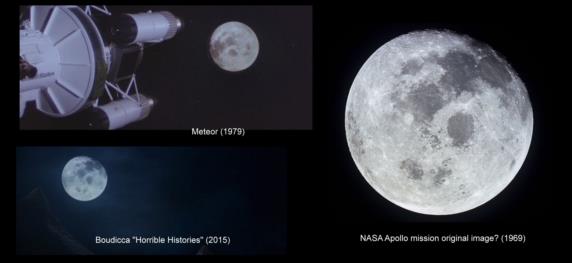
NavList:
A Community Devoted to the Preservation and Practice of Celestial Navigation and Other Methods of Traditional Wayfinding
From: Frank Reed
Date: 2024 Mar 12, 08:17 -0700
Some of you recall the strange image of the Moon in a recent dramatization of the life of Boudicca, the heroic "Queen of the Iceni" who nearly kicked the Romans out of Britain in about AD 60 (that's roughly a century before the publication of Ptolemy's Almagest, as it was known centuries later... Hard to imagine a pre-Ptolemaic world of astronomy!). Here's the original message on this topic with some images.
Last week I watched a bad movie (it's a hobby) and spotted the exact same Moon! Boudicca's moon traveled through time and ended up in 1979. The movie was "Meteor". I've heard about it for a long time but never got around to watching it. It's not so much a "bad" movie... it's a "not very good" movie.
I finally decided to watch Meteor after watching another movie which stars an airplane: Bombers B-52 (1957). That one also co-starred Natalie Wood and Karl Malden. Reading about that movie, I learned that they also starred together in Meteor along with Sean Connery as a grumpy NASA scientist and Henry Fonda as the President of the US who gets to say comforting, ominous things in his comforting, ominous voice. Why watch? Because I wanted to hear Natalie Wood speak Russian! She was, as it turns out, a fluent speaker. Her father was from the Russian far east, and her mother was from a city in southern, central Siberia called Barnaul. Alexander Wolf, NavList member, and more importantly, principal developer of "Stellarium" (in recent years at least) lives in Barnaul, if I remember correctly, so I found the connection entertaining.
Anyway, in the movie, ridiculous doomsday nuclear missiles positioned in LEO, Low Earth Orbit, are targeted towards the approaching asteroid, and the "camera" (a cheap special effect shot) shows us the Moon in the background. It is the same Moon (mirrored and rotated, but otherwise identical) from the Boudicca story! And as I noted in that earlier thread, the image is a NASA photo --public domain, no licensing cost. Some of you correctly deduced that the photo must have been taken by Apollo astronauts since it shows a significant fraction of the far side of the Moon which is never visible from Earth (nor from LEO).
I'm attaching a composite image showing the scene in "Meteor" (1979) and also the scene in that "Horrible Histories" Boudicca episode (an educational children's sing-along show, by the way, and you may "enjoy" this music video from it, too). Alongside the pop culture versions, I've added a high resolution copy of the original (or near enough).
I'm interested in two things in the original image. Can we describe a general geometric technique for determining distance from the Moon to the photographer's location (note that this is identical to the case of the image of Australia that we looked at a couple of weeks ago taken by the soon-to-be sideways lunar lander on its outbound flight to the Moon)? A number of us have explored some techniques, but is there a "best practice" approach here? What's the most efficient, reasonably accurate way to determine distance above the Moon from this photo? And also, what was the actual angular size of the Moon when the photo was taken? In thse pop culture examples (these are just a few among many, many examples using the same Moon image), the Moon has been dropped in with an apparent diameter of perhaps a few degrees. That's larger than it should be, of course, and typical for artistic depictions of the Moon in any era. Even "Stellarium" has a standard "Moon 4x" feature to enlarge the Moon for planetarium programming. But how big was the Moon "really" when this Apollo photo was taken? At a low enough altitude the Moon would fill the observer's field of view, maybe 90° wide or even more. Similarly that photo of the Earth with Australia looming large appears to show a small Earth "in the distance" but in reality, at such low altitude, the Earth nearly filled the field of view. What's the best way to calculate these things in a photo like this, treating the photo as the only evidence available?
Frank Reed







